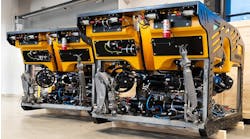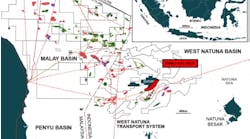OFFSHORE EUROPE Oryx, others elect to extend production on aging North Sea platforms
Oryx UK and partners have been assessing facilities on the Murchison platform, which came onstream in the UK Northern North Sea in 1980.Shell's submission to Greenpeace over the Brent Spar disposal has done little for the cause of low-cost field abandonment. Some UK operators are coming to the conclusion that it may be cheaper to keep facilities running beyond the end of their intended life.
The UK government supports this view. Earlier this year it awarded Unocal and partners a licence for a block close to the Heather Field which has been in production since 1978. The award came ahead of the 16th Licensing Round to allow the partners to speed up evaluation of reserves in this block: if these could be produced through Heather's facilities, the closure of this field could be postponed.
Others saw the light a little earlier. BP Exploration Europe calculated that its ageing Beatrice, Buchan, Clyde, and Thistle Fields strung out across the North Sea were taking up 17% of its management overheads in return for just 4% of production.
Rather than pay out 270 million to abandon these four fields, BP started a cost control exercise to keep them going for another four years. A mature assets team, called MAST, was assembled in 1994 to manage the four fields. Their actions to date - rationalizing the number of contractors, marine services, maintenance support, well operations and catering - has so far sliced 20% off combined production costs (currently 100 million).
Transactions
But one company found an alternative solution for dying fields - sell them. Last year Conoco accepted partner Oryx UK Energy Co's offer to buy out its stakes in Hutton, Murchison and various other newer fields. In return, Oryx relinquished its share of Britannia, Conoco's flagship gas condensate development in the UK.
From Oryx's point of view, Britannia was becoming too capital intensive, and strategically, the company was more into oil than gas. On Hutton and Murchison, says UK managing director Patricia Horsfall, "we saw potential for driving down costs", thereby extending the lives of the two fields.
Lower cost operations have been a hallmark of Oryx's management style in the Gulf of Mexico, partly out of necessity: it has been laden with large debts for some time. The Conoco transactions gave management the chance to transfer this style to the UK for the first time as an operator, from last January onwards.
Hutton and Murchison, located in the Northern North Sea, had been producing oil since the early '80s. In both cases, less than a sixth of the original reserves remained to be extracted, and operations were due to wind down from 1996. Oryx, though, saw potential for a stay of execution at least until 2000, by reducing opearting costs and fully exploiting reservoir potential. A further upside would be available through targetting new satellites.
This happened almost immediately on Hutton. In February, an extension was discovered via a new well which flowed at 20,000 b/d. It was drilled into a fault block which the previous regime considered had little potential. However, the well encountered over 150 ft of net hydrocarbon pay in the Brent Sandstone, following a revised mapping exercise based on new 3D seismic.
Subject to go-ahead from the Hutton partners, a fast-track development plan may be submitted shortly for the extension, known as Q West. Assuming approval from the Department of Trade and Industry, development would occur via new wells drilled from the Hutton TLP.
Murchison is based round a conventional steel platform with 22 producer and 10 injector wells. Two workovers were undertaken this spring and more intervention is planned later this year on currently shut-in wells. A sidetracked well may be drilled towards the end of 1995.
Around the same time, 3D seismic will probably be shot in acreage close to Hutton, but no shoots are planned for Murchison this year. Instead, Oryx and partners are looking to optimize the Murchison platform facilities through inter-related studies, namely:
- Gas balance situation - when to convert from export to import and associated facilities implications.
- Low pressure separation trials.
- Water handling capacity and relationships to individual well water cuts.
- Well by well production review and optimization.
Improved efficiency also translates as lower costs. By how much on the offshore facilities is a little difficult to quantify, says Horsfall, "...because there are certain fixed costs... but we would expect to achieve a 20% reduction". As for onshore support operations, a 30-40% lower outlay is feasible over the next two years, she claims.
In recent years, Oryx has moved towards contractor alliances in the US Gulf and Ecuador. "Our philosophy is to resource what's core to our business and contract out the rest." For Hutton and Murchison, that meant entrusting onshore support to Atlantic Power and Gas, Aberdeen which will manage this side of the business through to abandonment of the fields.
Forty-five APG staff memberms are working with a ten-strong Oryx team in Aberdeen under an incentive contract. Offshore, Oryx has retained the ex-Conoco workforce and the numerous ongoing third-party contracts.
Other measures for trimming expenditure are sharing of helicopters and supply boats with operators on neighboring fields, such as Ninian and North West Hutton - something which is happening increasingly in the UK sector. "Interestingly," says Horsfall, "one area where we haven't yet seen more sharing of resources is around emergency response. I'd have thought there would be a great opportunity to do this, or for a specialist company in Aberdeen to handle it."
Oryx's plans to prolong Hutton and Murchison production were a big selling point in gaining approaval for operatorship from the DTI. "Other oil companies have expressed quite a bit of interest in how we're approaching this," says Horsfall. "Some have come along to see what we're doing."
As proof of Oryx's commitment, it has not yet drawn up formal abandonment plans for the two facilities, although it did inherit full studies from Conoco.
Copyright 1995 Offshore. All Rights Reserved.



